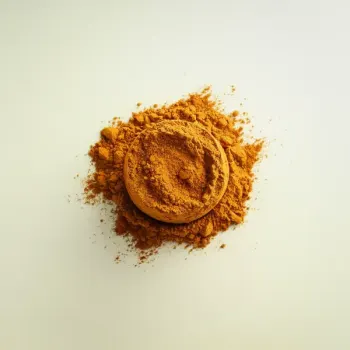Turmeric is a single, vibrant yellow-orange spice known for its earthy flavor and health benefits, while Curry Powder is a blend of spices including turmeric, offering a complex flavor profile with varying heat levels, used to enhance a variety of dishes.

Turmeric is a vibrant yellow-orange spice commonly used in South Asian and Middle Eastern cooking. It is derived from the rhizome of the Curcuma longa plant and is celebrated for its earthy flavor and potential health benefits, including its anti-inflammatory properties.

Curry Powder is a blend of spices that typically includes turmeric, coriander, cumin, fenugreek, and chili peppers, among others. Its exact composition can vary depending on the brand or regional preference. It's widely used to quickly add complex flavors to dishes.
Turmeric is a single spice with a slightly bitter, peppery flavor, known for its bright color. Curry Powder, on the other hand, is a spice mix that includes turmeric as one of its components, offering a more nuanced flavor profile with sweet, floral notes and varying levels of heat.

Your ultimate Recipe Box, Meal Planner, and Cooking Class all in one
In curries, turmeric provides a bold color and a subtle earthiness. It's ideal for enhancing the base notes of dishes like Dal Tadka or Aloo Gobi, where its flavor can complement without overpowering. Curry Powder shines in recipes such as Chicken Curry or Vegetable Korma, where a complex flavor spectrum is desired. It adds depth and warmth with a single ingredient.
Turmeric is perfect for a simple, fragrant Turmeric Rice where its color and subtle flavor can be the star. It's also great in rice pilafs, adding a hint of earthiness. For a more flavor-intense dish like Biryani or Curried Fried Rice, curry powder can be used to introduce a more complex and rounded spice profile.
Use turmeric in soups like Lentil Soup or Carrot Ginger Soup to add color and a touch of spice without overwhelming the other flavors. Curry powder is ideal for soups that require a robust flavor, such as Mulligatawny Soup or Curried Butternut Squash Soup, providing a full-bodied spice blend.
Both turmeric and curry powder contain curcumin, a compound with anti-inflammatory properties.
| Nutrient | Turmeric ( Per Teaspoon ) | Curry Powder ( Per Teaspoon ) |
|---|---|---|
| Fat | 0.1g | 0.3g |
| Iron | 1.65mg | 1.14mg |
| Protein | 0.3g | 0.4g |
| Calories | 9 | 8 |
| Manganese | 0.5mg | 0.2mg |
| Carbohydrates | 2g | 1.6g |
Turmeric can provide color but not the full flavor profile of curry powder. Use it carefully as a substitute.
Curry powder can range from mild to spicy, depending on the blend and the amount of chili peppers used.
Yes, turmeric contains curcumin, which contributes anti-inflammatory and antioxidant properties.
Yes, you can create a custom curry powder blend by mixing turmeric with spices like coriander, cumin, and chili powder.
Both should be stored in airtight containers away from direct sunlight and heat to preserve their flavor and color.